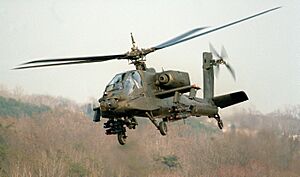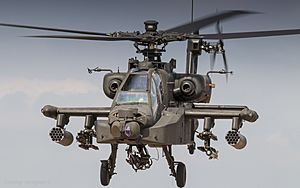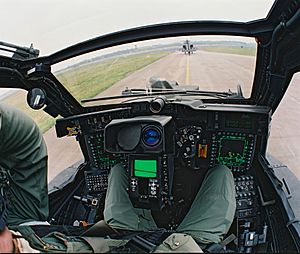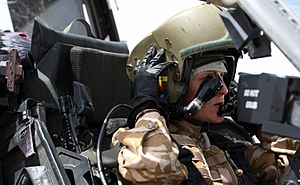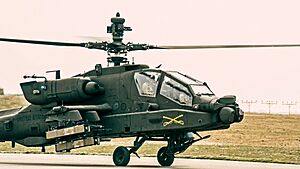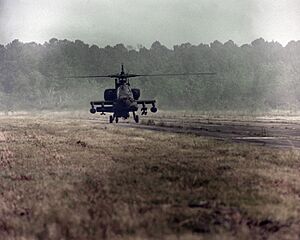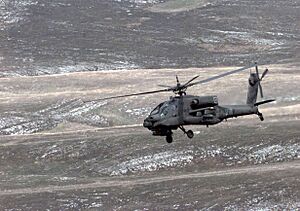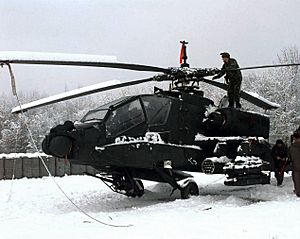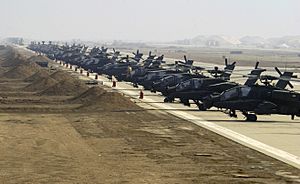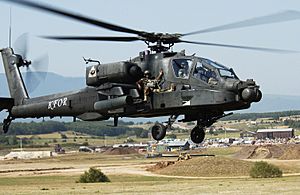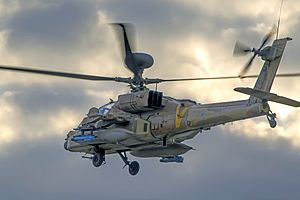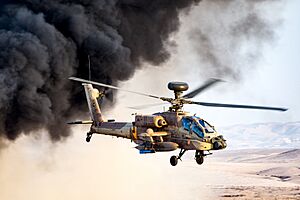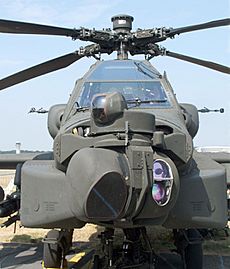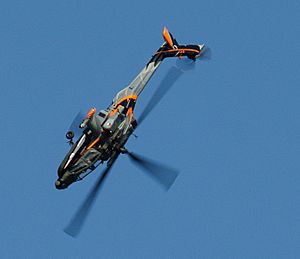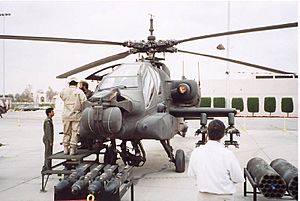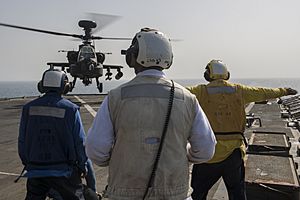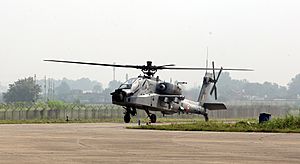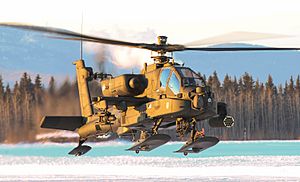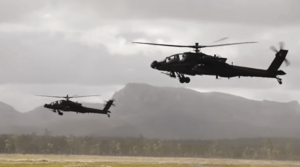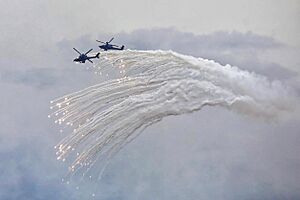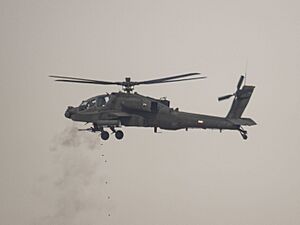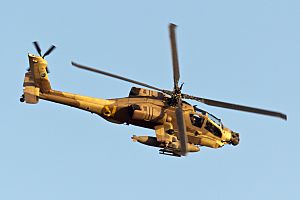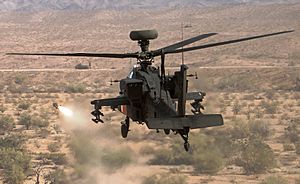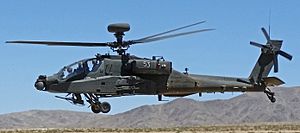Boeing AH-64 Apache facts for kids
Quick facts for kids AH-64 Apache |
|
|---|---|
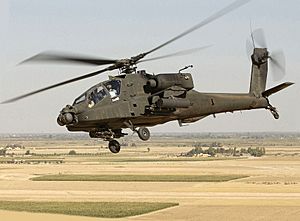
An AH-64 Apache from the U.S. Army's 101st Aviation Regiment in Iraq
|
|
| General information | |
| Type | Attack helicopter |
| National origin | United States |
| Manufacturer |
|
| Status | In service |
| Primary users | United States Army
|
| Number built | + 2,700 |
| History | |
| Manufactured | 1975–present |
| Introduction date | April 1986 |
| First flight | 30 September 1975 |
| Variants | AgustaWestland Apache |
The AH-64 Apache is a powerful American attack helicopter. It has two engines and a special cockpit for two crew members, one behind the other. The helicopter has sensors on its nose to find targets and help pilots see at night. It carries a 30 mm machine gun under its front and can hold missiles and rockets on its small wings. The Apache is built with extra systems to help it survive damage in battle.
This helicopter was first developed by Hughes Helicopters to replace the older Bell AH-1 Cobra. The first test flight was on September 30, 1975. The U.S. Army chose the Apache in 1976 and started full production in 1982. Later, McDonnell Douglas and then Boeing Defense, Space & Security took over its production. The Apache joined the U.S. Army in April 1986. An improved version, the AH-64D Apache Longbow, arrived in March 1997. By March 2024, over 5,000 Apaches had been delivered to the U.S. Army and many other countries.
The AH-64 Apache is mainly used by the U.S. Army. It is also a key attack helicopter for nations like Greece, Japan, Israel, the Netherlands, Singapore, and the United Arab Emirates. The United Kingdom even builds its own version called the AgustaWestland Apache. American Apaches have been used in conflicts in Panama, the Persian Gulf, Kosovo, Afghanistan, and Iraq. Israel uses its Apaches in Lebanon and the Gaza Strip. British and Dutch Apaches have also been part of wars in Afghanistan and Iraq.
Contents
- How the Apache Helicopter Was Developed
- Apache Helicopter Design
- Apache in Action
- Apache Helicopter Versions
- Images for kids
- Specifications (AH-64A/D)
- See also
How the Apache Helicopter Was Developed
Early Attack Helicopter Program
After a different helicopter project was canceled in 1972, the U.S. Army needed a new aircraft. They wanted a helicopter that could attack tanks and stay under Army control. This was important because of an agreement that stopped the Army from having fixed-wing combat aircraft. The Army wanted something better than the Bell AH-1 Cobra. It needed more firepower, better performance, and a longer range. It also had to be able to fly very low to the ground, following the land's shape.
So, in November 1972, the Army asked companies to propose designs for an "Advanced Attack Helicopter" (AAH). This project was so important that it was named one of the Army's "Big Five" projects in 1973. Several companies, including Bell Helicopter and Hughes Aircraft, submitted ideas. In July 1973, Bell and Hughes were chosen as finalists. Each company built a prototype helicopter for testing.
Hughes' prototype, the YAH-64A, first flew on September 30, 1975. Bell's prototype, the YAH-63A, flew the next day. After testing, the Army picked Hughes' YAH-64A in 1976. They liked its four-blade main rotor, which was better at handling damage. The YAH-63's landing gear was also less stable.
The AH-64A then moved into the next phase of the AAH program. Three pre-production Apaches were built, and the test helicopters were updated. During this time, weapons and sensor systems were added and tested. This included the AGM-114 Hellfire missile, which was designed to arm helicopters with an effective anti-tank weapon.
Starting Production
In 1981, three pre-production AH-64As were given to the U.S. Army for more tests. The tests went well, but the Army decided to use a more powerful engine, the T700-GE-701. In late 1981, the helicopter was named the Apache, following the tradition of naming Army helicopters after Native American tribes.
Full production of the Apache was approved in 1982. The first production helicopter was completed in 1983 at Hughes Helicopter's factory in Arizona. In 1984, McDonnell Douglas bought Hughes Helicopters. Later, in 1997, Boeing merged with McDonnell Douglas, and the helicopter unit became part of Boeing Defense, Space & Security.
In 1985, a government report found that some design issues still needed fixing. The Army worked with the company to solve these problems. For example, the main rotor blades, made from steel and composite materials, needed to last longer. After several design changes, the rotor blades could last for 1,400 flight hours by early 1991.
As of 2024, the AH-64E is being produced at a steady rate. Boeing can make up to 98 Apaches per year. The U.S. Army believes that with more investment, production could reach 144 aircraft per year.
Further Improvements
During the 1980s, McDonnell Douglas looked into an AH-64B version with an updated cockpit and new systems. In 1988, money was approved for a multi-stage upgrade. But new technology led to bigger changes instead. In August 1990, the development of the AH-64D Apache Longbow was approved.
The first AH-64D prototype flew on April 15, 1992. Testing finished in April 1995. During tests, six AH-64D helicopters were compared to a larger group of older AH-64As. The results showed that the AH-64D was much better at surviving and attacking. It was seven times more likely to survive and four times more deadly than the AH-64A.
Full production of the AH-64D was approved in October 1995. A large contract was signed in August 1996 to upgrade 232 AH-64As to the AH-64D version. The first production AH-64D flew on March 17, 1997, and was delivered on March 31.
Other companies also help build parts of the Apache. AgustaWestland makes components for the Apache, including for the British Army's version. Since 2004, Korea Aerospace Industries has been the only company making the Apache's main body.
By May 2019, Boeing tested a model of a "compound" Apache. This design included a pusher propeller and a small wing to make it faster and fly further. This was part of a competition for the U.S. Army's future aircraft.
Apache Helicopter Design
General Features
The AH-64 Apache has a main rotor with four blades and a tail rotor with four blades. The two crew members sit one behind the other. The pilot sits behind and slightly above the co-pilot/gunner. Both crew members can fly the helicopter and use its weapons.
The Apache is powered by two General Electric T700 engines, with their exhausts high up on each side. Different engine models have been used. British Apaches use engines from Rolls-Royce. In 2004, GE Aviation started making more powerful T700-GE-701D engines for the AH-64Ds.
The crew area and rotor blades are designed to withstand hits from 23 mm rounds. The helicopter's body has about 2,500 pounds of protection. It also has a special fuel system that seals itself if hit, to prevent fires. There is a clear shield between the pilot and gunner to protect at least one crew member in case of a direct hit.
The Apache was built to be safe in crashes. It has a strong structure, special landing gear, seats, and a fuel system that help reduce injuries in an accident.
On a normal day, the AH-64 can climb 1,775 feet per minute and reach a height of 21,000 feet. However, on a hot day, its climbing ability and maximum height are reduced because the air is less dense.
Electronics and Targeting Systems
One amazing feature of the Apache is its helmet-mounted display system, called IHADSS. This allows either the pilot or gunner to control the helicopter's 30 mm machine gun with their head movements. So, the gun points wherever they look! The gun can also be fixed forward or controlled by the Target Acquisition and Designation System (TADS). Newer Apaches use Lockheed Martin's Arrowhead targeting system.
U.S. Army pilots practice shooting with the Apache using live ammunition and simulated missiles. The AH-64 is expected to hit a wheeled vehicle at 800 to 1,200 meters at least once for every 30 shots fired.
The AH-64 was designed to work in tough conditions, day or night, and in bad weather. It uses systems like the TADS/PNVS for night vision, infrared countermeasures, and GPS. Apaches with the Longbow radar can find up to 256 targets at the same time within 50 kilometers.
In August 2012, some U.S. Army AH-64Ds got a new system called the Ground Fire Acquisition System (GFAS). This system finds and targets sources of ground fire in any light condition. It uses two sensor pods and a thermal camera to pinpoint muzzle flashes.
In 2014, new targeting and surveillance sensors were being developed. These would give crews high-resolution color images, replacing older black-and-white systems. Lockheed received a contract in January 2016 to upgrade the Arrowhead system for better color imaging and longer range. The U.S. Army also adapted its Apaches for better performance over water, adding radar to detect small ships and Link 16 data-links for better communication.
Weapons and Setup
The AH-64 can be used for many different combat roles. Besides its 30 mm machine gun, the Apache carries various weapons on its small wing pylons. These usually include AGM-114 Hellfire anti-tank missiles and Hydra 70 unguided 70 mm rockets. The Hellfire missile can destroy tanks up to 6,500 meters away.
Since 2005, a Hellfire missile with a special warhead, called AGM-114N, has been used against ground forces and in city battles. In October 2015, the U.S. Army ordered its first batch of Advanced Precision Kill Weapon System (APKWS) guided 70 mm rockets for the Apache.
The Apache can also carry Stinger and AIM-9 Sidewinder air-to-air missiles. External fuel tanks can be added to the wings to fly longer distances. Stinger missiles are often used on Apaches in other countries, as they might not have as many air superiority aircraft to control the skies.
The AH-64E can even control unmanned aerial vehicles (UAVs), or drones. The U.S. Army uses this to scout for enemies, a job previously done by the OH-58 Kiowa. Apaches can take control of drones like the RQ-7 Shadow or MQ-1C Grey Eagle from ground stations. Drones can search for enemies and, if they have a laser, can mark targets for the Apache or other friendly aircraft.
Boeing has suggested that the AH-64 could be fitted with a directed energy weapon, like a small laser. This laser could be used to destroy enemy communication equipment. In June 2017, the Army and Raytheon successfully tested a high-energy laser system from an AH-64.
In July 2016, the AH-64 successfully tested the MBDA Brimstone anti-armor missile. In January 2020, the U.S. Army started using the Spike NLOS missile on AH-64E Apaches. This missile allows the helicopter to attack targets from a greater distance.
Apache in Action
United States Military Use
20th Century Operations
In January 1984, the U.S. Army officially accepted its first production AH-64A. Pilot training began later that year. The first Apache unit started training in April 1986. Two Apache units with 68 helicopters were sent to Europe in September 1987 for military exercises.
When the Apache was first used, its night vision capabilities showed it could operate far beyond where other attack helicopters usually stayed. It was also found that the Apache had a radio system that allowed it to work well with the U.S. Air Force. This helped in joint operations, where the Apache often helped other aircraft by finding targets.
The Apache was first used in combat in 1989 during Operation Just Cause in Panama. It flew over 240 combat hours, attacking targets mostly at night. General Carl Stiner, who led the operation, said: "You could fire that Hellfire missile through a window from four miles away at night."
Almost half of all U.S. Apaches were sent to Saudi Arabia after Iraq invaded Kuwait in 1990. During Operation Desert Storm in January 1991, eight AH-64As, guided by special helicopters, destroyed part of Iraq's radar network. This allowed other attack aircraft to fly in without being seen. Each Apache carried rockets, Hellfire missiles, and an extra fuel tank.
During the 100-hour ground war, 277 AH-64s took part. They destroyed 278 tanks and many other Iraqi vehicles, totaling over 500 targets. Only one AH-64 was lost in the war, crashing after being hit by a rocket-propelled grenade (RPG). The crew survived. While effective, the Apache had some problems with maintenance and getting spare parts.
The AH-64 also played roles in the Balkans during conflicts in Bosnia and Kosovo in the 1990s. In 1999, 24 Apaches were sent to Albania for combat in Kosovo. This required a huge amount of equipment to be moved. However, the Apaches faced problems with training, night vision gear, and fuel tanks. No Apache combat missions happened in Kosovo because of strong Yugoslav air defenses. Two Apaches were lost in training exercises there.
21st Century Operations
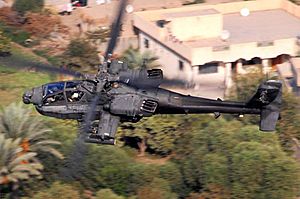
U.S. Apaches were used in Operation Enduring Freedom in Afghanistan starting in 2001. They were the only Army aircraft that could provide accurate close air support during intense early fighting. Apaches often flew in small teams, but their actions were sometimes controlled too closely by commanders. U.S. AH-64Ds in Afghanistan and Iraq often flew without the Longbow Radar because there were no armored threats.
In 2003, the AH-64 took part in the invasion of Iraq during Operation Iraqi Freedom. On March 24, 2003, 31 Apaches were damaged. One was shot down during an attack on an Iraqi armored brigade near Karbala. Iraqi tank crews had set up a trap and used their guns effectively. The AH-64 landed mostly intact, and its crew was captured. The helicopter was destroyed by an air strike the next day. This event showed that the Apache, despite being seen as a "flying tank," could be vulnerable to rifle fire. After this, the Army quietly changed its plans for Apaches to lead deep attacks into enemy lines.
By the end of U.S. military operations in Iraq in December 2011, several Apaches had been shot down or lost in accidents. In 2006, an Apache was downed by a Soviet-made missile in Iraq. In 2007, four Apaches were destroyed on the ground by insurgent mortar fire. Many Apaches that took heavy damage were still able to complete their missions and return safely. By 2011, U.S. Army Apaches had flown over 3 million hours since 1975.
On February 21, 2013, the first U.S. Army unit received the AH-64E Apache Guardian. By mid-2013, 24 AH-64Es were delivered. In March 2014, the AH-64E was first used in combat in Afghanistan. From April to September 2014, these Apaches had an 88 percent readiness rate. The AH-64E flies 20 mph faster than the AH-64D, reducing response time by 57 percent. It also uses fuel more efficiently, staying in the air longer. Taliban forces were reportedly surprised by the AH-64E attacking sooner and for longer periods.
The AH-64Es also worked with medium and large drones to find targets. Guardian pilots often controlled drones and watched their video feeds. This allowed them to see the battlefield from a distance.
In 2014, the Army began moving all Apaches from the Army Reserve and National Guard to the active Army. This was to use them as scout helicopters, replacing the OH-58 Kiowa. Using the AH-64 for scouting would be cheaper than upgrading the Kiowa. AH-64Es can control drones like the MQ-1C Grey Eagle for scouting missions.
In July 2014, Apaches were sent to Baghdad to protect embassy staff from Islamic State attacks. In October 2014, Apaches began missions against Islamic State ground forces. In June 2016, Apaches supported the Iraqi Army's Mosul offensive and the Battle of Mosul, sometimes flying night missions. In December 2019, two Apaches provided support for U.S. Marines securing the U.S. embassy in Baghdad after militants tried to storm it.
In March 2024, two Apache crashes within two days led to increased examination of the helicopter.
Israel's Apache Fleet
The Israeli Air Force (IAF) first received AH-64As in 1990. By 2000, they had 42 Apaches. In April 2005, Boeing delivered the IAF's first AH-64D. In Israeli service, the AH-64A was called Peten (Cobra), and the AH-64D was named Saraph (venomous/fiery winged serpent).
During the 1990s, Israeli AH-64As often attacked Hezbollah outposts in Lebanon. During the al-Aqsa Intifada in the 2000s, Apaches were used to target senior Hamas figures. In 2004, Israeli AH-64s were involved in the killing of Ahmed Yassin, a Hamas leader. This attack also killed 7 bystanders and was widely condemned.
IAF Apaches played a big role in the 2006 Lebanon War, striking Hezbollah forces in Lebanon. During this war, two AH-64As collided, killing one pilot. Another AH-64D crashed due to a rotor problem, killing its two crew members. Israeli officials praised the Apache for its role in Operation Cast Lead in 2008 against Hamas in Gaza. IAF Apaches often patrol the skies over Gaza and frequently strike insurgents.
In the 2010s, the IAF upgraded its AH-64A fleet. By 2013, IAF AH-64As were getting a major upgrade to their electronics. These AH-64As are being upgraded to a standard similar to the AH-64D. IAF Apaches can carry Spike anti-tank missiles instead of Hellfire missiles.
IAF AH-64s have also been used in air-to-air combat. On May 24, 2001, an IAF Apache shot down a Lebanese civilian aircraft. On February 10, 2018, an Apache destroyed an Iranian drone that entered Israeli airspace from Syria.
United Kingdom's Apache Fleet
The UK previously used a modified version of the AH-64D, called the Westland WAH-64 Apache. The British Army calls it the Apache AH1. AgustaWestland built 67 WAH-64 Apaches under license from Boeing. The British version has more powerful Rolls-Royce engines and folding rotor blades for use on naval ships.
In July 2016, the UK Ministry of Defence confirmed a deal to buy 50 AH-64Es from the U.S. These new Apaches are built in Arizona. The older WAH-64s were retired by 2024 and replaced by the AH-64E models. The first two AH-64Es were delivered to the British Army on November 26, 2020.
Netherlands' Apache Fleet
The Dutch government first showed interest in Apaches in the late 1980s. In 1994, after a competition, the Royal Netherlands Air Force ordered 30 AH-64D Apaches in 1995. Deliveries started in 1998 and finished in 2002. The Dutch Apaches have a special self-protection system to counter infrared missile threats.
The Dutch Apaches were first sent to Djibouti, Africa, in 2001. They also worked with U.S. Apaches in Bosnia and Herzegovina. In 2004, six Dutch AH-64s were sent to Iraq to support ground forces. They provided close combat support, showed force, and gave reconnaissance information. In February 2006, six AH-64s were sent to Afghanistan to support NATO forces.
Soon after being sent to Hamid Karzai International Airport in Afghanistan, a pair of Dutch Apaches came under gunfire near Kabul in April 2004. In December 2007, a Dutch Apache flew into power lines during a night exercise in the Netherlands, causing an emergency landing and a blackout. On March 17, 2015, a Dutch Apache crashed during a training mission in Mali, killing both pilots.
In February 2018, the Netherlands decided to upgrade all its AH-64Ds to the latest AH-64E standard. This upgrade process began in November 2021, and the RNLAF is expected to receive the upgraded AH-64Es between 2023 and 2025.
Saudi Arabia's Apache Fleet
Following the 1991 Gulf War, Saudi Arabia bought twelve AH-64As for the Royal Saudi Land Force. In August 2006, Saudi Arabia began talks to upgrade its Apaches to the AH-64D version. In September 2008, the U.S. Government approved Saudi Arabia's request to buy 12 AH-64Ds. In October 2010, Saudi Arabia asked for another 70 AH-64Ds as part of a large arms deal.
In November 2009, the Royal Saudi Land Force used Apaches in Operation Scorched Earth against rebels in neighboring Yemen. The Apaches launched air strikes against Houthi rebels. In January 2010, the rebels claimed to have shot down an Apache, but the Saudi military denied this.
Starting in March 2015, Saudi Arabia and the United Arab Emirates used their AH-64s in combat during the military operation in Yemen. The Apaches were mainly used for border patrol and strikes in Northwestern Yemen. Several Saudi and Emirati Apaches have been lost in incidents and from enemy fire. In March 2017, an Apache reportedly attacked a refugee boat, killing 42 refugees. Saudi Arabia denied involvement.
United Arab Emirates' Apache Fleet
The United Arab Emirates bought 30 AH-64As between 1991 and 1994. They started upgrading them to the AH-64D version in 2008. In December 2016, the U.S. State Department approved a plan to sell another 37 AH-64Es to the UAE.
A UAE AH-64 was reportedly lost in October 2017. A replacement was approved by the US in 2019.
Egypt's Apache Fleet
In 1995, the Egyptian Air Force ordered 36 AH-64As. These Apaches had the same electronics as the U.S. fleet, except for their radio equipment. In 2000, Boeing announced an order to upgrade Egypt's Apaches to the AH-64D version, but without the Longbow radar. In 2009, Egypt asked for another 12 AH-64D Block IIs with Longbow radars.
In August 2012, the Egyptian Armed Forces used their Apaches in a large military operation to take back control of the Sinai Peninsula from militants. The Apaches reportedly destroyed three vehicles and killed at least 20 militants. In September 2015, an Egyptian Apache attacked a group of foreign tourists in the Western Desert, killing 12 people. The Egyptian Interior Ministry said the group was mistaken for militants and was in a restricted area.
In November 2018, the U.S. Department of State approved the sale of ten AH-64Es to Egypt. The Apache is still in service with Egyptian Armed Services and is being further upgraded.
India's Apache Fleet
Indian Air Force
In 2008, the Indian Air Force (IAF) looked for 22 new attack helicopters. In December 2010, India asked to buy 22 Apaches. On October 5, 2012, the IAF confirmed it had chosen the Apache. In April 2013, the Indian Ministry of Defence decided that the 22 AH-64s would go to the IAF. India ordered the 22 AH-64Es in 2015.
On May 11, 2019, the IAF received its first AH-64E. On September 3, 2019, eight AH-64Es joined the IAF's 125 Helicopter Squadron. The second squadron for Apache helicopters was formed in October 2019. The last batch of five helicopters was delivered on July 11, 2020.
The Apaches were also used at Leh Air Force Station during the 2020–2021 China–India skirmishes.
On April 3, 2024, an Indian Air Force Apache made a safe landing in the Ladakh region during a training flight. The helicopter was damaged due to the rough terrain. Both pilots were safe. This was the first such incident involving an Apache in India. The helicopter parts were transported for repair.
On June 6, 2025, another Apache made a safe landing during a training flight near Saharanpur. The problem was fixed, and the helicopter returned to its base. On June 13, an Apache made an emergency landing in Pathankot district. The technical issue was resolved, and the helicopter was flown back safely.
Indian Army
On June 12, 2018, the U.S. approved a possible sale of six more AH-64Es to India. In February 2020, another six for the Indian Army were ordered, with deliveries planned to begin in 2023. These attack helicopters work with India's own HAL Prachand attack helicopters.
On January 1, 2024, Army officials said the Indian Army Aviation Corps expected to get its first Apaches in February–March 2024. This is to help the army protect its tanks when the Indian Air Force is not available. They will be sent to Jodhpur, near the India–Pakistan border, to improve security against Pakistani tanks. On March 15, 2024, the Army Aviation Corps formed a new squadron at Jodhpur to operate the Apache. The first three Apaches were expected by May 2024, and the rest by July 2024. However, as of August 2024, no Apaches had been delivered to the Army.
Due to supply chain issues, as of September 2024, the first three Apache helicopters are expected by December 2024 or January 2025, with the next three a few months later.
As of July 2025, the Defence Minister of India Rajnath Singh confirmed that the first three Apache AH-64E attack helicopters from the United States would be delivered by July 15, 2025, and the next three by November 2025. However, reports on July 15 indicated another delay to the following week. These helicopters will be used for anti-armor and air assault missions.
Other Countries Using Apache Helicopters
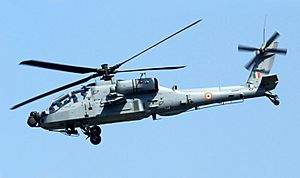
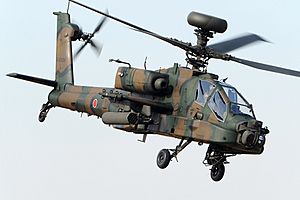
The Apache has been sold to several countries. It is popular in the Middle East due to its reputation from the Gulf War. The U.S. Army remains its main user, and Poland will become the largest user in Europe.
 Australia Australian Army – 29 AH-64Es are on order.
Australia Australian Army – 29 AH-64Es are on order. Egypt Egyptian Air Force – Has 46 AH-64Ds.
Egypt Egyptian Air Force – Has 46 AH-64Ds. Greece Hellenic Army – Has 28 AH-64A/Ds.
Greece Hellenic Army – Has 28 AH-64A/Ds. India Indian Air Force – Has 22 AH-64Es as of July 2020.
India Indian Air Force – Has 22 AH-64Es as of July 2020. India Indian Army – Has 6 AH-64Es on order.
India Indian Army – Has 6 AH-64Es on order. Indonesia Indonesian Army – Has 8 AH-64Es.
Indonesia Indonesian Army – Has 8 AH-64Es. Israel Israeli Air Force – Has 48 AH-64A/Ds.
Israel Israeli Air Force – Has 48 AH-64A/Ds. Japan Japan Ground Self-Defense Force – Has 12 AH-64Ds.
Japan Japan Ground Self-Defense Force – Has 12 AH-64Ds. Kuwait Kuwait Air Force – Has 24 AH-64Ds.
Kuwait Kuwait Air Force – Has 24 AH-64Ds. Morocco Royal Moroccan Air Force – Has 36 AH-64Es on order, with 6 delivered by March 2025.
Morocco Royal Moroccan Air Force – Has 36 AH-64Es on order, with 6 delivered by March 2025. Netherlands Royal Netherlands Air and Space Force – Has 28 AH-64Es.
Netherlands Royal Netherlands Air and Space Force – Has 28 AH-64Es. Poland Polish Land Forces – Has 96 AH-64Es on order, and 8 AH-64Ds leased.
Poland Polish Land Forces – Has 96 AH-64Es on order, and 8 AH-64Ds leased. Qatar Qatar Emiri Air Force – Has 24 AH-64Es.
Qatar Qatar Emiri Air Force – Has 24 AH-64Es. Saudi Arabia Royal Saudi Land Forces – Has 47 AH-64A/D/Es.
Saudi Arabia Royal Saudi Land Forces – Has 47 AH-64A/D/Es. Saudi Arabia Saudi Arabia National Guard – Has 12 AH-64Es.
Saudi Arabia Saudi Arabia National Guard – Has 12 AH-64Es. Singapore
Singapore
Republic of Singapore Air Force – Has 19 AH-64Ds.
 South Korea Republic of Korea Army – Has 36 AH-64Es. Another 36 AH-64Es were approved for sale.
South Korea Republic of Korea Army – Has 36 AH-64Es. Another 36 AH-64Es were approved for sale. Taiwan (Republic of China) Republic of China Army – Has 29 AH-64Es.
Taiwan (Republic of China) Republic of China Army – Has 29 AH-64Es. United Arab Emirates United Arab Emirates Air Force – Has 28 AH-64D/Es.
United Arab Emirates United Arab Emirates Air Force – Has 28 AH-64D/Es. United Kingdom British Army – Has 50 AH-64Es.
United Kingdom British Army – Has 50 AH-64Es. United States United States Army – Has about 750 total, with an estimated 160 AH-64Ds and 590 AH-64Es as of January 2025.
United States United States Army – Has about 750 total, with an estimated 160 AH-64Ds and 590 AH-64Es as of January 2025.
Future and Possible Users
Iraq asked to buy 24 AH-64s in April 2013. The sale was approved by the U.S. Congress in January 2014. However, Iraq did not accept the offer, and it expired in August 2014.
In July 2019, Australia began looking for a helicopter to replace its Eurocopter Tiger ARH helicopters. On January 15, 2021, Australia announced it had chosen the AH-64E. They plan to get 29 AH-64Es, with the first 12 ready by 2026.
In October 2019, the Bangladesh Air Force (BAF) was offered two types of attack helicopters and chose the AH-64. However, because of the Apache's high cost, the BAF chose the Russian Mi-28NE Night Hunter instead.
In November 2019, the U.S. State Department approved a sale of 24 AH-64Es to Morocco, with an option for 12 more. This allows Morocco to negotiate an order.
On April 30, 2020, the U.S. Defense Security Cooperation Agency announced a possible sale to the Philippines of either six AH-1Z attack helicopters or six AH-64Es.
On April 21, 2022, Poland chose between the AH-64E and Bell's AH-1Z Viper to modernize its attack helicopter fleet. On September 8, 2022, Polish Minister of Defence Mariusz Błaszczak announced that the AH-64E had won. Poland plans to buy 96 helicopters to form six squadrons. The contract includes logistics, training, ammunition, and spare parts.
Apache Helicopter Versions
AH-64A
The AH-64A is the original production attack helicopter. It has a crew of two in an armored compartment. It is powered by two GE T700 engines. The A-model first used the -701 engine version, but after 1990, it was upgraded to the more powerful -701C version.
U.S. Army AH-64As are being converted into AH-64Ds. The last U.S. Army AH-64A was taken out of service in July 2012 for conversion. By September 2012, Boeing received a contract to convert the last 16 AH-64As into the AH-64D Block II version. This was completed by December 2013.
AH-64D
The AH-64D Apache Longbow has a modern glass cockpit and advanced sensors. The most noticeable part is the AN/APG-78 Longbow radar system, which is in a dome above the main rotor. This radar allows the helicopter to find targets while staying hidden behind obstacles like hills or buildings. The AN/APG-78 can track up to 128 targets at once and attack up to 16 targets within 30 seconds.
A radio system in the helicopter allows it to share information with ground units and other Apaches. This means one helicopter can find targets, and others can attack them. The AH-64D is powered by upgraded T700-GE-701C engines. The front of the helicopter was made larger to fit new systems that improve its ability to survive, navigate, and communicate. In February 2003, the first Block II Apache was delivered to the U.S. Army, with improved digital communications. The Japanese Apache AH-64DJP version is based on the AH-64D and can carry AIM-92 Stinger air-to-air missiles for self-defense.
AH-64E
The AH-64E was previously known as the AH-64D Block III, but it was renamed AH-64E Guardian in 2012. It has better digital communication, more powerful T700-GE-701D engines, and improved landing gear. It can also control unmanned aerial vehicles (UAVs), or drones. New composite rotor blades, tested in 2004, make it faster, climb better, and carry more weight. Deliveries started in November 2011. Full production was approved in October 2012.
Newer AH-64E models include systems that help pilots make decisions and new self-diagnostic abilities. The updated Longbow radar can detect targets over the sea, which could allow for naval attacks. It also has a new data-link system to communicate with all Army drones. The AH-64E is designed for maritime use. The U.S. Army is also interested in extra fuel tanks for longer flights. As of 2024, 500 AH-64Es have been delivered.
Work on an even more upgraded AH-64E, version 6.5, began in 2021 and first flew in 2023. The AH-64E has reportedly had some issues with its electrical systems.
Sea Apache
During the 1980s, naval versions of the AH-64A were considered for the United States Marine Corps and Navy. Different designs were studied with changes to the landing gear, electronics, and weapons. The Marine Corps tested the Apache in September 1981, including operations from ships. However, no money was provided for a naval version, and the Marine Corps continued to use the AH-1.
The Canadian Forces Maritime Command also looked into naval Apaches. In 2004, British Army Apaches were tested on the Royal Navy's HMS Ocean, a helicopter carrier, to see if they could operate from ships. During the 2011 military intervention in Libya, the British Army used Apaches extensively from HMS Ocean. In 2013, U.S. AH-64Ds were tested on several U.S. Navy ships.
Images for kids
Specifications (AH-64A/D)
Data from Jane's All the World's Aircraft 2000–2001, Jane's All the World's Aircraft 2010–2011, Apache AH-64 Boeing (McDonnell Douglas) 1976–2005
General characteristics
- Crew: 2 (pilot, and co-pilot/gunner)
- Length: 58 ft 2 in (17.73 m) * Fuselage length: 49 ft 5 in (15.06 m)
- Height: 12 ft 8 in (3.87 m)
- Empty weight: 11,387 lb (5,165 kg)
- Gross weight: 17,650 lb (8,006 kg)
- Max takeoff weight: 23,000 lb (10,433 kg)
- Powerplant: 2 × General Electric T700-GE-701 turboshaft engines, 1,690 shp (1,260 kW) each (upgraded to 1,890 shp (1,409 kW) T700-GE-701C for AH-64A/D from 1990)
- Main rotor diameter: 48 ft 0 in (14.63 m)
- Main rotor area: 1,908.5 sq ft (177.31 m2) 4-bladed main-rotor and 4-bladed tail-rotor with 55° non-orthogonal blade offset
- Blade section: root: HH-02; tip: NACA 64A006
Performance
- Maximum speed: 158 kn (182 mph; 293 km/h)
- Cruise speed: 143 kn (165 mph; 265 km/h)
- Never exceed speed: 197 kn (227 mph; 365 km/h)
- Range: 257 nmi (296 mi; 476 km) with Longbow radar mast
- Combat range: 260 nmi (299 mi; 482 km)
- Ferry range: 1,024 nmi (1,178 mi; 1,896 km)
- Service ceiling: 20,000 ft (6,100 m)
- Disk loading: 9.8 lb/sq ft (48 kg/m2)
- Power/mass: 0.18 hp/lb (0.30 kW/kg)
Armament
- Guns: 1× 30 mm (1.18 in) M230 Chain Gun with 1,200 rounds as part of the Area Weapon Subsystem
- Hardpoints: Four pylon stations on the stub wings. Longbows also have a station on each wingtip for an AIM-92 Stinger twin missile pack.
- Rockets: Hydra 70 70 mm, CRV7 70 mm, and APKWS 70 mm air-to-ground rockets
- Missiles: Typically AGM-114 Hellfire variants; Air-to-Air Stinger (ATAS); AGM-65 Maverick and Spike missiles may also be carried.
Avionics
- Lockheed Martin/Northrop Grumman AN/APG-78 Longbow fire-control radar (Note: can only be mounted on the AH-64D/E)
See also
 In Spanish: Boeing AH-64 Apache para niños
In Spanish: Boeing AH-64 Apache para niños
- Aviation and Missile Research, Development, and Engineering Center
- United States Army Aviation and Missile Command
- Aircraft related to this one
- AgustaWestland Apache
- Bell YAH-63
- Similar aircraft
- Agusta A129 Mangusta
- Bell AH-1 SuperCobra
- Bell AH-1Z Viper
- CAIC Z-10
- Denel Rooivalk
- Eurocopter Tiger
- HAL Prachand
- Harbin WZ-19
- IAIO Toufan
- Kamov Ka-50
- Mil Mi-24
- Mil Mi-28
- Panha 2091
- TAI/AgustaWestland T129
- Lists related to this aircraft
- List of active United States military aircraft
- List of aviation shootdowns and accidents during the Iraq War
- List of rotorcraft
- List of military electronics of the United States


